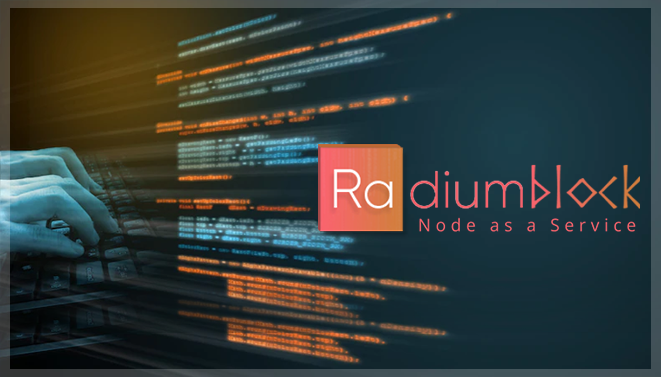Blockchain is a distributed ledger technology (DLT) based on a peer-to-peer (P2P) topology. Data can be stored globally on hundreds of thousands of servers, allowing network users to see all the available data entries at any one time. This transparency makes it almost impossible to gain control of the network.
Blockchain aims to provide transparent transactions for businesses, including the ability to create secure networks and real-time communication with partners around the world.
However, installing and configuring nodes is quite laborious and time-consuming, which paved the way for node providers, software companies that provide services to other startups, or companies looking to use the blockchain.
Radiumblock offers nodes to businesses and developers as a tool to help them build DApps faster, thereby eliminating the requirement for engineers to maintain and manage nodes.
What is the node used for?
A node based on a blockchain is an open-source, cross-platform runtime that allows developers to create numerous services. The P2P protocol allows nodes to communicate within the network and transfer information about transactions and new blocks.
The network nodes are responsible for the correctness and reliability of the storage of the data entered the blockchain. A node stores a copy of the transactions/data in the blockchain. Thanks to these nodes, any user can access and see all data transactions made or stored in the network.
Launching a network node used to be the only way to connect to the blockchain. Each new node participates in the blockchain network's decentralization, shortening transaction time and lowering fees.
Setting up a node allows you to earn a modest amount of money on transactions made through your channels.
Nodes participate in sharing information about transactions and the number of funds, consensus, confirming transactions, storing copies of confirmations, and engaging in the construction of new blocks on the chain, for which they receive a reward.
A business using nodes can receive commissions for transfers made to buy or sell cryptocurrency assets on the exchange.
How to implement a node?
To deploy a full node, one must consider many requirements. Earlier it was possible to run a node on a low-powered computer; now that blockchains have become popular networks, memory and CPU power are critical for a successful deployment. There are minimum hardware requirements for deploying a node. The hardware requirements differ for every other cryptocurrency.
You can connect a node to the mainnet or run it on a testnet for any of your purposes: testing, development, etc.
The standard node runs directly to the console. These nodes run as a background process by writing the service to the system or starting a node on the screen. You should carefully monitor what mode the node starts up. If the node is running in test mode, it will not be able to track transactions.
To install a node, you need to create a folder to store blockchain data somewhere on your file system. For example, one requires 380 GB today to synchronize the entire bitcoin blockchain.
Syncing can take a long time. Hardware issues can occur, and a paused download will restart after the disruption is resolved. The client starts the blockchain synchronization process once one makes a copy.
The next step is to send requests to nodes on the blockchain to check if the node is working.
You will also want to monitor the node, for which you can use a standard service availability check on the TCP port. If the node fails, you will need to restart it manually.
Issues you may face when deploying a node, yourself:
1. Limited Bandwidth: Some internet plans will charge extra for using excess bandwidth not included in the plan. Make sure you do not have any traffic restrictions before deploying your node. Also, the Internet connection may end up being unstable. A reboot is required if the node sync with the blockchain network is interrupted.
2. The site deployment on your company network may slow down or cause a bottleneck in normal network traffic.
3. A third party (hackers) may find out that a new full node is up and try to hack it. You are entirely responsible for ensuring no one hacks your node.
Slashing will occur if a validator misbehaves (for example, goes offline, attacks the network, or runs modified software) on the network. The validators and nominators will lose a percentage of their staked/bonded DOT. The Treasury will add any of the reduced DOT. The reason for this (instead of burning them or distributing them as bounties) is that the Council can reverse the outages simply by paying from the Treasury. This way would be helpful in situations such as a buggy runtime causing outages or forcing validators to go offline through no fault. In the case of legitimate slashing, tokens are taken away from malicious validators to those building the ecosystem through the normal Treasury process.
Pools of validators with a larger total share supporting them will be reduced more harshly than less popular ones, so it is encouraged that nominators shift their nominations to less popular validators to reduce potential losses
In short, launching a full node on your own requires financial costs to purchase equipment that meets the requirements of that node, ensuring uninterrupted Internet connection and the ability to use the command line.
How does Radiumblock work?
Anyone can install the node themselves, but technical challenges and a lack of competence and experience can significantly complicate this task.
Radiumblock solves technical issues that may arise by managing all the tasks and activities required to keep the blockchain infrastructure operational.
The node provider implements and uses required technologies and infrastructure to implement, set up and maintain the nodes connected to the blockchain.
Depending on your business needs, the provider can provide access to Bitcoin, Ethereum, Monero, Litecoin and other networks. The provider will be taking responsibility for all actions related to the node.
As a client, the node provider is a means to enter and exit the blockchain.
Using Radiumblock services, you can focus on your core business and strategies, relying on professionals to manage your blockchain infrastructure and performance.
Local blockchain can be more expensive than similar cloud offerings in the market.
The prohibitive cost is due to:
• Initial costs (personnel, infrastructure, hardware, software, licensing, consultancy, etc.).
• Operating costs (management, monitoring, etc.).
• Dismantling (archive, the dismantling of equipment, etc.).
The service cost can be high initially due to high resource costs.
The actual costs of using other cloud solutions depend on other factors:
• the total number of requests to the node at a given time.
• the stability of the node.
• timely update of the node.
• security, etc.
Summary of Node-As-A-Service
We reviewed the concept of a blockchain node, the issues a developer might face when implementing a node, and how node service providers operate. With today's technologies, developers do not need to use complicated software to bring blockchain into their products, maintain wallets, or download copious amounts of raw blockchain data, as there is an alternative.
Even if you are a novice coder with no hands-on experience building blockchain-related programs, you can easily apply the APIs in your line of business; all you need to do is choose a node API provider. Radiumblock’s node as a service can become an efficient tool to get analytics and data of your DApps on the blockchain through the nodes served by the platform.
Key takeaways
Nodes on the blockchain store a complete copy of the digital ledger and are responsible for the reliability of the stored data. Developers use nodes to build blockchain-based applications.
• When it comes to implementing a full blockchain node, the hardware, software, and network connection must meet specific needs.
• The requirement of running and maintaining blockchain nodes is technically hassle-free, time-consuming, and expensive.
• The node service provider is an alternative to the automatic execution of full blockchain nodes; it offers tools and infrastructure for developers to configure and manage nodes connected to the blockchain.
Node service providers offer APIs for developers so they can create automated workflows.



